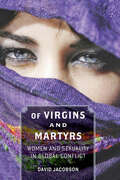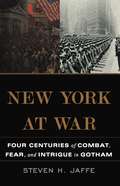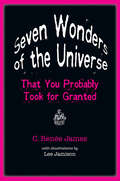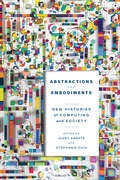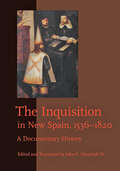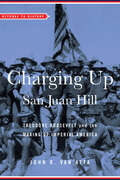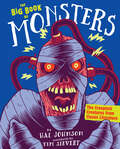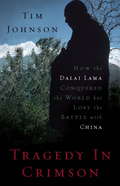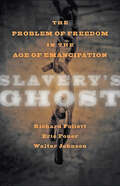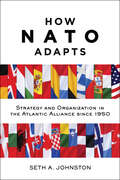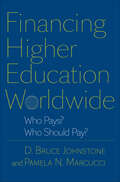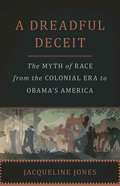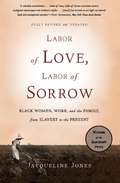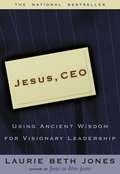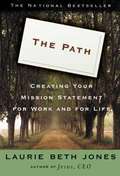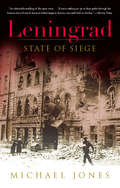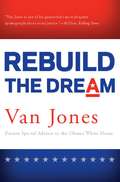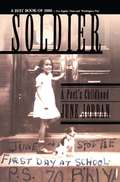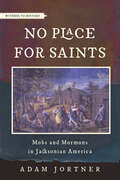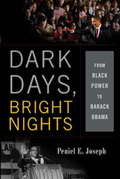- Table View
- List View
Of Virgins and Martyrs: Women and Sexuality in Global Conflict (Themes in Global Social Change)
by David JacobsonWomen's bodies have become a battleground. Around the world, people argue about veiling, schooling for Afghan girls, and "SlutWalk" protests, all of which involve issues of women's sexuality and freedom. Globalization, with its emphasis on human rights and individuality, heats up these arguments. In Of Virgins and Martyrs, David Jacobson takes the reader on a fascinating tour of how self-identity developed throughout history and what individualism means for Muslim societies struggling to maintain a sense of honor in a globalized twenty-first century.Some patriarchal societies have come to see women’s control of their own sexuality as a threat to a way of life that goes back thousands of years. Many trace their lineage to tribal cultures that were organized around the idea that women’s virginity represents the honor of male relatives and the good of the community at large. Anyone or anything that influences women to the contrary is considered a corrupting and potentially calamitous force. Jacobson analyzes the connection between tribal patriarchy and Muslim radicalism through an innovative tool—the tribal patriarchy index. This index helps to illuminate why women's sexuality, dress, and image so compel militant Muslim outrage and sometimes violent action, revealing a deeper human story of how women's status defines competing moral visions of society and why this present clash is erupting with such ferocity.
New York at War: Four Centuries of Combat, Fear, and Intrigue in Gotham
by Steven H. Jaffethe need to try.Stretching from the colonial era to 9/11 and beyond, New York at War is that most rare of books: a work of history that is at once local and international, timely and timeless. Bringing a unique lens to bear on the world's most celebrated and contested city, Jaffe reveals the unimaginable ways the city has changed-and how it has stubbornly endured-under threats both external and internal.
Seven Wonders of the Universe That You Probably Took for Granted
by C. Renée JamesTime. Gravity. Night. So much of what surrounds us feels familiar and mundane. But each is a wonder that reveals profound insights into the world around us.C. Renée James's whimsical tour of seven everyday experiences—night, light, stuff, gravity, time, home, and wonder—opens the Universe to fantastical contemplation. Light? Although we need it to see, there's much more to it than meets the eye. Stuff? When it comes down to it, things are almost entirely empty space—99.9% nothing—especially when you get to the atomic level. Home? James's contemplation of our place in the Universe shows that it's not just a place to hang your hat—and that there’s really nothing else like it. James introduces each of these seven wonders with a simple question that appears to be easily answered. The questions are deceptive, though—as is James's casual, light-hearted style. Underneath lie such concepts as relativity, matter and antimatter, and the electromagnetic spectrum. Her accessible discussion uses common analogies and entertaining illustrations to provide a bundle of detail on historical discoveries and to provoke serious pondering. Fun and edifying, Seven Wonders of the Universe That You Probably Took for Granted is an inviting introduction to secret knowledge of our everyday world. This book may be 99.9% nothing, but the thoughts it will inspire are massive.
Chess for Kids: How to Play and Win
by Richard JamesThis is the perfect introduction to chess for children from the age of seven upwards. The book contains 30 short lessons, starting with learning about the board and the pieces, then the moves of each piece in turn, then the vital concepts of check, checkmate and stalemate, and finally basic strategy and thinking skills. Quizzes and puzzles reinforce what the children learn.The book uses the characters of the 7-year-old twins Sam and Alice who are always arguing and fighting. They decide to join the army where they are told about an impending invasion of aliens from the planet Caïssa. The outcome of the invasion will be decided by a game of living chess. During their lessons they learn about the battlefield and the different types of soldier and get to play the part of each in turn.
Abstractions and Embodiments: New Histories of Computing and Society (Studies in Computing and Culture)
by Janet Abbate and Stephanie DickCutting-edge historians explore ideas, communities, and technologies around modern computing to explore how computers mediate social relations.Computers have been framed both as a mirror for the human mind and as an irreducible other that humanness is defined against, depending on different historical definitions of "humanness." They can serve both liberation and control because some people's freedom has historically been predicated on controlling others. Historians of computing return again and again to these contradictions, as they often reveal deeper structures.Using twin frameworks of abstraction and embodiment, a reformulation of the old mind-body dichotomy, this anthology examines how social relations are enacted in and through computing. The authors examining "Abstraction" revisit central concepts in computing, including "algorithm," "program," "clone," and "risk." In doing so, they demonstrate how the meanings of these terms reflect power relations and social identities. The section on "Embodiments" focuses on sensory aspects of using computers as well as the ways in which gender, race, and other identities have shaped the opportunities and embodied experiences of computer workers and users. Offering a rich and diverse set of studies in new areas, the book explores such disparate themes as disability, the influence of the punk movement, working mothers as technical innovators, and gaming behind the Iron Curtain. Abstractions and Embodiments reimagines computing history by questioning canonical interpretations, foregrounding new actors and contexts, and highlighting neglected aspects of computing as an embodied experience. It makes the profound case that both technology and the body are culturally shaped and that there can be no clear distinction between social, intellectual, and technical aspects of computing. Contributors: Janet Abbate, Marc Aidinoff, Troy Kaighin Astarte, Ekaterina Babinsteva, André Brock, Maarten Bullynck, Jiahui Chan, Gerardo Con Diaz, Liesbeth De Mol, Stephanie Dick, Kelcey Gibbons, Elyse Graham, Michael J. Halvorson, Mar Hicks, Scott Kushner, Xiaochang Li, Zachary Loeb, Lisa Nakamura, Tiffany Nichols, Laine Nooney, Elizabeth Petrick, Cierra Robson, Hallam Stevens, Jaroslav Švelch
The Inquisition in New Spain, 1536–1820: A Documentary History
by John F. Chuchiak IVThe Inquisition! Just the word itself evokes, to the modern reader, endless images of torment, violence, corruption, and intolerance committed in the name of Catholic orthodoxy and societal conformity. But what do most people actually know about the Inquisition, its ministers, its procedures? This systematic, comprehensive look at one of the most important Inquisition tribunals in the New World reveals a surprisingly diverse panorama of actors, events, and ideas that came into contact and conflict in the central arena of religious faith.Edited and annotated by John F. Chuchiak IV, this collection of previously untranslated and unpublished documents from the Holy Office of the Inquisition in New Spain provides a clear understanding of how the Inquisition originated, evolved, and functioned in the colonial Spanish territories of Mexico and northern Central America. The three sections of documents lay out the laws and regulations of the Inquisition, follow examples of its day-to-day operations and procedures, and detail select trial proceedings. Chuchiak’s opening chapter and brief section introductions provide the social, historical, political, and religious background necessary to comprehend the complex and generally misunderstood institutions of the Inquisition and the effect it has had on societal development in modern-day Mexico, Guatemala, El Salvador, Nicaragua, and Honduras. Featuring fifty-eight newly translated documents, meticulous annotations, and trenchant contextual analysis, this documentary history is an indispensable resource for anyone seeking to understand the Inquisition in general and its nearly three-hundred-year reign in the New World in particular.
Charging Up San Juan Hill: Theodore Roosevelt and the Making of Imperial America (Witness to History)
by John R. Van AttaBelow a Cuban sun so hot it stung their eyes, American troops hunkered low at the base of Kettle Hill. Spanish bullets zipped overhead, while enemy artillery shells landed all around them. Driving Spanish forces from the high ground would mean gaining control of Santiago, Cuba, and, soon enough, American victory in the Spanish-American War. No one doubted that enemy fire would claim a heavy toll, but these unusual citizen-soldiers and their unlikely commander;¢;‚¬;€?39-year-old Colonel Theodore Roosevelt;¢;‚¬;€?had volunteered for exactly this kind of mission.In Charging Up San Juan Hill, John R. Van Atta recounts that fateful day in 1898. Describing the battle;€™s background and its ramifications for Roosevelt, both personal and political, Van Atta explains how Roosevelt;€™s wartime experience prompted him to champion American involvement in world affairs. Tracking Roosevelt;€™s rise to the presidency, this book argues that the global expansion of American influence;¢;‚¬;€?indeed, the building of an empire outward from a strengthened core of shared values at home;¢;‚¬;€?connected to the broader question of cultural sustainability as much as it did to the increasing of trade, political power, and military might.At the turn of the twentieth century, Theodore Roosevelt personified American confidence. A New York City native and recovered asthmatic who spent his twenties in the wilds of the Dakota Territory, Roosevelt leapt into the war with Spain with gusto. He organized a band of cavalry volunteers he called the Rough Riders and, on July 1, 1898, took part in their charge up a Cuban hill the newspapers called San Juan, launching him to national prominence. Without San Juan, Van Atta argues, Roosevelt;¢;‚¬;€?whom the papers credited for the victory and lauded as a paragon of manhood;¢;‚¬;€?would never have reached a position to become president.
Charging Up San Juan Hill: Theodore Roosevelt and the Making of Imperial America (Witness to History)
by John R. Van AttaBelow a Cuban sun so hot it stung their eyes, American troops hunkered low at the base of Kettle Hill. Spanish bullets zipped overhead, while enemy artillery shells landed all around them. Driving Spanish forces from the high ground would mean gaining control of Santiago, Cuba, and, soon enough, American victory in the Spanish-American War. No one doubted that enemy fire would claim a heavy toll, but these unusual citizen-soldiers and their unlikely commander;¢;‚¬;€?39-year-old Colonel Theodore Roosevelt;¢;‚¬;€?had volunteered for exactly this kind of mission.In Charging Up San Juan Hill, John R. Van Atta recounts that fateful day in 1898. Describing the battle;€™s background and its ramifications for Roosevelt, both personal and political, Van Atta explains how Roosevelt;€™s wartime experience prompted him to champion American involvement in world affairs. Tracking Roosevelt;€™s rise to the presidency, this book argues that the global expansion of American influence;¢;‚¬;€?indeed, the building of an empire outward from a strengthened core of shared values at home;¢;‚¬;€?connected to the broader question of cultural sustainability as much as it did to the increasing of trade, political power, and military might.At the turn of the twentieth century, Theodore Roosevelt personified American confidence. A New York City native and recovered asthmatic who spent his twenties in the wilds of the Dakota Territory, Roosevelt leapt into the war with Spain with gusto. He organized a band of cavalry volunteers he called the Rough Riders and, on July 1, 1898, took part in their charge up a Cuban hill the newspapers called San Juan, launching him to national prominence. Without San Juan, Van Atta argues, Roosevelt;¢;‚¬;€?whom the papers credited for the victory and lauded as a paragon of manhood;¢;‚¬;€?would never have reached a position to become president.
The Big Book of Monsters: The Creepiest Creatures from Classic Literature
by Hal JohnsonLiterature is extra fun when it's spooky! This illustrated compendium of 25 of the spookiest and most nefarious monsters from classic literature—from Dracula to the Jabberwocky—includes a playful retelling of each monster's story accompanied by full-color illustration and sidebars about its literary origins, including authorship and genre. For ages 8-12.
Tragedy in Crimson: How the Dalai Lama Conquered the World but Lost the Battle with China
by Tim JohnsonTragedy in Crimson is award-winning journalist Tim Johnson&’s extraordinary account of the cat-and-mouse game embroiling China and the Tibetan exile community over Tibet. Johnson reports from the front lines, trekking to nomad resettlements to speak with the people who guard Tibet&’s slowly vanishing culture; and he travels alongside the Dalai Lama in the campaigns for Tibetan sovereignty. Johnson unpacks how China is using its economic power around the globe to assail the Free Tibet movement. By encouraging massive Chinese migration and restricting Tibetan civil rights, the Chinese are also working to dilute Tibetan culture within Tibet itself. He also takes a sympathetic but unsentimental look at the Dalai Llama, a popular figure in the West who is regarded as a failure by many of his own people. Staggering in scope, vivid and audacious in its narrative aims, Tragedy in Crimson tells the story of a people on the brink of cultural extinction and the rising nation that is quashing them.
Slavery's Ghost: The Problem of Freedom in the Age of Emancipation (The Marcus Cunliffe Lecture Series)
by Walter Johnson Eric Foner Richard FollettPresident Abraham Lincoln freed millions of slaves in the South in 1863, rescuing them, as history tells us, from a brutal and inhuman existence and making the promise of freedom and equal rights. This is a moment to celebrate and honor, to be sure, but what of the darker, more troubling side of this story? Slavery’s Ghost explores the dire, debilitating, sometimes crushing effects of slavery on race relations in American history. In three conceptually wide-ranging and provocative essays, the authors assess the meaning of freedom for enslaved and free Americans in the decades before and after the Civil War. They ask important and challenging questions: How did slaves and freedpeople respond to the promise and reality of emancipation? How committed were white southerners to the principle of racial subjugation? And in what ways can we best interpret the actions of enslaved and free Americans during slavery and Reconstruction? Collectively, these essays offer fresh approaches to questions of local political power, the determinants of individual choices, and the discourse that shaped and defined the history of black freedom. Written by three prominent historians of the period, Slavery’s Ghost forces readers to think critically about the way we study the past, the depth of racial prejudice, and how African Americans won and lost their freedom in nineteenth-century America.
How NATO Adapts: Strategy and Organization in the Atlantic Alliance since 1950 (The Johns Hopkins University Studies in Historical and Political Science #132)
by Seth A. JohnstonToday;€™s North Atlantic Treaty Organization, with nearly thirty members and a global reach, differs strikingly from the alliance of twelve created in 1949 to "keep the Americans in, the Russians out, and the Germans down." These differences are not simply the result of the Cold War;€™s end, 9/11, or recent twenty-first-century developments but represent a more general pattern of adaptability first seen in the incorporation of Germany as a full member of the alliance in the early 1950s. Unlike other enduring post;€“World War II institutions that continue to reflect the international politics of their founding era, NATO stands out for the boldness and frequency of its transformations over the past seventy years.In this compelling book, Seth A. Johnston presents readers with a detailed examination of how NATO adapts. Nearly every aspect of NATO;¢;‚¬;€?including its missions, functional scope, size, and membership;¢;‚¬;€?is profoundly different than at the organization;€™s founding. Using a theoretical framework of "critical junctures" to explain changes in NATO;€™s organization and strategy throughout its history, Johnston argues that the alliance;€™s own bureaucratic actors played important and often overlooked roles in these adaptations. Touching on renewed confrontation between Russia and the West, which has reignited the debate about NATO;€™s relevance, as well as a quarter century of post;€“Cold War rapprochement and more than a decade of expeditionary effort in Afghanistan, How NATO Adapts explores how crises from Ukraine to Syria have again made NATO;€™s capacity for adaptation a defining aspect of European and international security. Students, scholars, and policy practitioners will find this a useful resource for understanding NATO, transatlantic relations, and security in Europe and North America, as well as theories about change in international institutions.
How NATO Adapts: Strategy and Organization in the Atlantic Alliance since 1950 (The Johns Hopkins University Studies in Historical and Political Science #132)
by Seth A. JohnstonToday;€™s North Atlantic Treaty Organization, with nearly thirty members and a global reach, differs strikingly from the alliance of twelve created in 1949 to "keep the Americans in, the Russians out, and the Germans down." These differences are not simply the result of the Cold War;€™s end, 9/11, or recent twenty-first-century developments but represent a more general pattern of adaptability first seen in the incorporation of Germany as a full member of the alliance in the early 1950s. Unlike other enduring post;€“World War II institutions that continue to reflect the international politics of their founding era, NATO stands out for the boldness and frequency of its transformations over the past seventy years.In this compelling book, Seth A. Johnston presents readers with a detailed examination of how NATO adapts. Nearly every aspect of NATO;¢;‚¬;€?including its missions, functional scope, size, and membership;¢;‚¬;€?is profoundly different than at the organization;€™s founding. Using a theoretical framework of "critical junctures" to explain changes in NATO;€™s organization and strategy throughout its history, Johnston argues that the alliance;€™s own bureaucratic actors played important and often overlooked roles in these adaptations. Touching on renewed confrontation between Russia and the West, which has reignited the debate about NATO;€™s relevance, as well as a quarter century of post;€“Cold War rapprochement and more than a decade of expeditionary effort in Afghanistan, How NATO Adapts explores how crises from Ukraine to Syria have again made NATO;€™s capacity for adaptation a defining aspect of European and international security. Students, scholars, and policy practitioners will find this a useful resource for understanding NATO, transatlantic relations, and security in Europe and North America, as well as theories about change in international institutions.
Financing Higher Education Worldwide: Who Pays? Who Should Pay?
by D. Bruce Johnstone Pamela N. MarcucciNo issue in higher education is as salient, or as controversial, as finance. As demand for higher education around the world grows, so do the costs associated with it, especially as governments shoulder less of the burden. Tuition fees rise and student loan debt grows. Who pays for these surging costs? Who should pay? D. Bruce Johnstone and Pamela N. Marcucci examine the universal phenomenon of cost-sharing in higher education—where financial responsibility shifts from governments and taxpayers to students and families. They find that growing costs for education far outpace public revenue streams that once supported it. Even with financial aid and scholarships defraying some of these costs, students are responsible for a greater share of the cost of higher education.Featuring comprehensive economic and policy data, the authors' international comparative approach shows how economically diverse countries all face similar cost-sharing challenges. So, who should pay for higher education? While cost-sharing is both politically and ideologically debated, Johnstone and Marcucci contend that, for almost all countries, it is imperative for the financial health of colleges and universities, bringing better efficiency, equity, and responsiveness. Financing Higher Education Worldwide combines sophisticated economic explanations with sensitive political and cultural analyses of the financial pressures facing higher education throughout the world.
A Dreadful Deceit: The Myth of Race from the Colonial Era to Obama's America
by Jacqueline JonesIn 1656, a planter in colonial Maryland tortured and killed one of his slaves, an Angolan man named Antonio who refused to work the fields. Over three centuries later, a Detroit labor organizer named Simon Owens watched as strikebreakers wielding bats and lead pipes beat his fellow autoworkers for protesting their inhumane working conditions. Antonio and Owens had nothing in common but the color of their skin and the economic injustices they battled-yet the former is what defines them in America’s consciousness. In A Dreadful Deceit, award-winning historian Jacqueline Jones traces the lives of these two men and four other African Americans to reveal how the concept of race has obscured the factors that truly divide and unite us. Expansive, visionary, and provocative, A Dreadful Deceit explodes the pernicious fiction that has shaped American history.
Labor of Love, Labor of Sorrow: Black Women, Work, and the Family, from Slavery to the Present
by Jacqueline JonesThe forces that shaped the institution of slavery in the American South endured, albeit in altered form, long after slavery was abolished. Toiling in sweltering Virginia tobacco factories or in the kitchens of white families in Chicago, black women felt a stultifying combination of racial discrimination and sexual prejudice. And yet, in their efforts to sustain family ties, they shared a common purpose with wives and mothers of all classes.In Labor of Love, Labor of Sorrow, historian Jacqueline Jones offers a powerful account of the changing role of black women, lending a voice to an unsung struggle from the depths of slavery to the ongoing fight for civil rights.
Labor of Love, Labor of Sorrow: Black Women, Work, and the Family, from Slavery to the Present
by Jacqueline JonesThe forces that shaped the institution of slavery in the American South endured, albeit in altered form, long after slavery was abolished. Toiling in sweltering Virginia tobacco factories or in the kitchens of white families in Chicago, black women felt a stultifying combination of racial discrimination and sexual prejudice. And yet, in their efforts to sustain family ties, they shared a common purpose with wives and mothers of all classes.In Labor of Love, Labor of Sorrow, historian Jacqueline Jones offers a powerful account of the changing role of black women, lending a voice to an unsung struggle from the depths of slavery to the ongoing fight for civil rights.
Jesus, CEO: Using Ancient Wisdom for Visionary Leadership
by Laurie Beth JonesEnhance and strengthen your corporate leadership skills with this guide to spirituality in business from a bestselling Christian consultant and speaker.Bestselling author Laurie Beth Jones brings you the ultimate guide to transforming your team and sparking inspiration in your business. In Jesus, CEO, Jones compares Jesus to a CEO who turned a disorganized "staff" of twelve into a thriving, long-lasting enterprise.With the twenty-fifth anniversary edition of Jesus, CEO, Jones revises and updates her original modernized guidance, ensuring that everyone can continue to apply the ancient wisdom pulled straight from the Bible.Filled with fresh, practical, and profound advice, Jesus, CEO helps managers motivate their teams and themselves. Jones divides this advice into three sections: strength of self-mastery, strength of actions, and strength of relationships. By teaching readers how to reinvent all aspects of their business according to the ultimate CEO, Jesus, CEO becomes the handbook you need for corporate success.
The Path: Creating Your Mission Statement for Work and for Life
by Laurie Beth JonesIndividuals and companies have been learning what history has demonstrated all along -- that people or groups with carefully defined missions have always led and surpassed those who have none. Yet the process of outlining that mission statement has been, up to now, an arduous one that all too few have committed the time, energy, and resources to undertake. In The Path, best-selling author Laurie Beth Jones provides inspiring and practical advice to lead readers through every step of both defining and fulfilling a mission. With more than ten years' experience in assisting groups and individuals, Jones offers clear, step-by-step guidance that can make writing a mission statement take a matter of hours rather than months or years. Rich with humor, exercises, mediations, and case histories, The Path is essential reading for anyone seeking a lighter, clearer way in the world.
Leningrad: State of Siege
by Michael Jones"All offers of surrender from Leningrad must be rejected,” wrote Adolph Hitler on September 29, 1941, at the outset of Operation Barbarossa. "In this struggle for survival, we have no interest in keeping even a proportion of the city's population alive.”During the famed 900-day siege of Leningrad, the German High Command deliberately planned to eradicate the city's population through starvation. Viewing the Slavs as sub-human, Hitler embarked on a vicious program of ethnic cleansing. By the time the siege ended in January 1944, almost a million people had died. Those who survived would be marked permanently by what they endured as the city descended into chaos.In Leningrad, military historian Michael Jones chronicles the human story of this epic siege. Drawing on newly available eyewitness accounts and diaries, he reveals the true horrors of the ordeal-including stories long-suppressed by the Soviets of looting, criminal gangs, and cannibalism. But he also shows the immense psychological resources on which the citizens of Leningrad drew to survive against desperate odds. At the height of the siege, for instance, an extraordinary live performance of Shostakovich's Seventh Symphony profoundly strengthened the city's will to resist.A riveting account of one of the most harrowing sieges of world history, Leningrad also portrays the astonishing power of the human will in the face of even the direst catastrophe.
Jedburgh Justice and Kentish Fire: The Origins of English in Ten Phrases and Expressions
by Paul Anthony JonesDid you know that Jedburgh Justice is ‘executing someone first, then giving them a trial’? Or that Kentish Fire is ‘applauding sarcastically to silence your opponents’? From the author of Haggard Hawks and Paltry Poltroons, this is a fascinating collection of curious phrases and expressions from the English language, together with the stories of their etymology and anecdotes about their use in history. Where Haggard Hawks focused on lists of ten words of a particular kind, this collection instead focuses on lists phrases and expressions, also arranged by their quirky and specific origins. The contents will include: 10 PHRASES DERIVED FROM PLACES IN BRITAIN (Jedburgh justice, Kentish fire, Scarborough warning…) 10 PHRASES DERIVED FROM PLACES IN LONDON (A draught on the pump at Aldgate, Kent Street ejectment…) 10 PHRASES DERIVED FROM PLACES IN AMERICA (Hollywood yes, Michigan bankroll, Chicago Overcoat…) 10 LATIN PHRASES USED IN ENGLISH (Quid pro quo, nunc est bibendum…) 10 FRENCH PHRASES USED IN ENGLISH (La vie en rose, C’est la guerre, Revenons à nos moutons…) 10 SHAKESPEAREAN EXPRESSIONS (Gild the lily, Salad days, All that glitters is not gold…) 10 LITERARY EXPRESSIONS (A thing of beauty is a joy forever, Abandon hope all ye who enter here…) 10 PHRASES FROM COMICS & CARTOONS (Keep up with the Joneses, Mutt and Jeff…) 10 PHRASES FROM SONGS (Miss Otis regrets, The birds and the bees, Potato po-tah-to…) 10 WAYS OF SAYING ‘WOW’ (Great Scott, My stars, Mamma mia…)
Rebuild the Dream
by Van JonesIn Rebuild the Dream, green economy pioneer Van Jones reflects on his journey from grassroots outsider to White House insider. For the first time, he shares intimate details of his time in government – and reveals why he chose to resign his post as a special advisor to the Obama White House.Jones puts his hard-won lessons to good use, proposing a powerful game plan to restore hope, fix our democracy and renew the American Dream. The American Dream means different things to people, but the center of gravity is always the same: an ordinary person—who was not born with great wealth, but who is willing to work hard and play by the rules—should be able to find employment, live in a good community, make progress financially, retire with dignity, and give his or her children a better life. That dream is fading. On Main Street, too many people are working harder than ever – while falling further behind. They play by the rules, but cannot succeed. At the same time, other Americans, including the worst of Wall Street, break every rule, but cannot fail – because someone has already decided that they are &“too big&” to fail. The American Dream has been turned upside down and inside out. It is time to set things right. As the first Obama administration official to write a book about his experiences, Jones offers a unique perspective. In explaining why the 2008 &“hope&” bubble burst, he unveils the seven biggest mistakes made by the White House and its supporters. He explores the origin and fate of the movements that helped to elect President Obama, as well as those that have challenged and shaped his presidency. Along the way, Jones systematically reveals surprising parallels between Obama&’s people-powered campaign, the Tea Party and Occupy Wall Street. At this pivotal moment, Jones argues that we must make our economy respect the 99% and work for the 100%, not just the 1%. He proposes serious solutions that fit the scale of our problems. Rebuild the Dream sets forth bold ideas inspired by the progressive values that made the twentieth century the &“American Century.&” It shows how key public policies and investments can create millions of good, American jobs. America is still the best idea in the world. The American middle class is still her greatest invention. Rebuild the Dream is dedicated to the proposition that – with the right strategy– both can be preserved and strengthened for generations to come.
Soldier: A Poet's Childhood
by June JordanWritten with exceptional beauty throughout, Soldier stands and delivers an eloquent, heart-breaking, hilarious and hopeful, witness to the beginnings of a truly extraordinary, American life.
No Place for Saints: Mobs and Mormons in Jacksonian America (Witness to History)
by Adam JortnerThe emergence of the Mormon church is arguably the most radical event in American religious history. How and why did so many Americans flock to this new religion, and why did so many other Americans seek to silence or even destroy that movement?Mormonism exploded across America in 1830, and America exploded right back. By 1834, the new religion had been mocked, harassed, and finally expelled from its new settlements in Missouri. Why did this religion generate such anger? And what do these early conflicts say about our struggles with religious liberty today? In No Place for Saints, the first stand-alone history of the Mormon expulsion from Jackson County and the genesis of Mormonism, Adam Jortner chronicles how Latter-day Saints emerged and spread their faith—and how anti-Mormons tried to stop them. Early on, Jortner explains, anti-Mormonism thrived on gossip, conspiracies, and outright fables about what Mormons were up to. Anti-Mormons came to believe Mormons were a threat to democracy, and anyone who claimed revelation from God was an enemy of the people with no rights to citizenship. By 1833, Jackson County's anti-Mormons demanded all Saints leave the county. When Mormons refused—citing the First Amendment—the anti-Mormons attacked their homes, held their leaders at gunpoint, and performed one of America's most egregious acts of religious cleansing. From the beginnings of Mormonism in the 1820s to their expansion and expulsion in 1834, Jortner discusses many of the most prominent issues and events in Mormon history. He touches on the process of revelation, the relationship between magic and LDS practice, the rise of the priesthood, the questions surrounding Mormonism and African Americans, the internal struggles for leadership of the young church, and how American law shaped this American religion. Throughout, No Place for Saints shows how Mormonism—and the violent backlash against it—fundamentally reshaped the American religious and legal landscape. Ultimately, the book is a story of Jacksonian America, of how democracy can fail religious freedom, and a case study in popular politics as America entered a great age of religion and violence.
Dark Days, Bright Nights: From Black Power to Barack Obama
by Peniel E. JosephThe Civil Rights Movement is now remembered as a long-lost era, which came to an end along with the idealism of the 1960s. In Dark Days, Bright Nights, acclaimed scholar Peniel E. Joseph puts this pat assessment to the test, showing the 60s-particularly the tumultuous period after the passage of the 1965 Voting Rights Act-to be the catalyst of a movement that culminated in the inauguration of Barack Obama.Joseph argues that the 1965 Voting Rights Act burst a dam holding back radical democratic impulses. This political explosion initially took the form of the Black Power Movement, conventionally adjudged a failure. Joseph resurrects the movement to elucidate its unfairly forgotten achievements.Told through the lives of activists, intellectuals, and artists, including Malcolm X, Huey P. Newton, Amiri Baraka, Tupac Shakur, and Barack Obama, Dark Days, Bright Nights will make coherent a fraught half-century of struggle, reassessing its impact on American democracy and the larger world.
